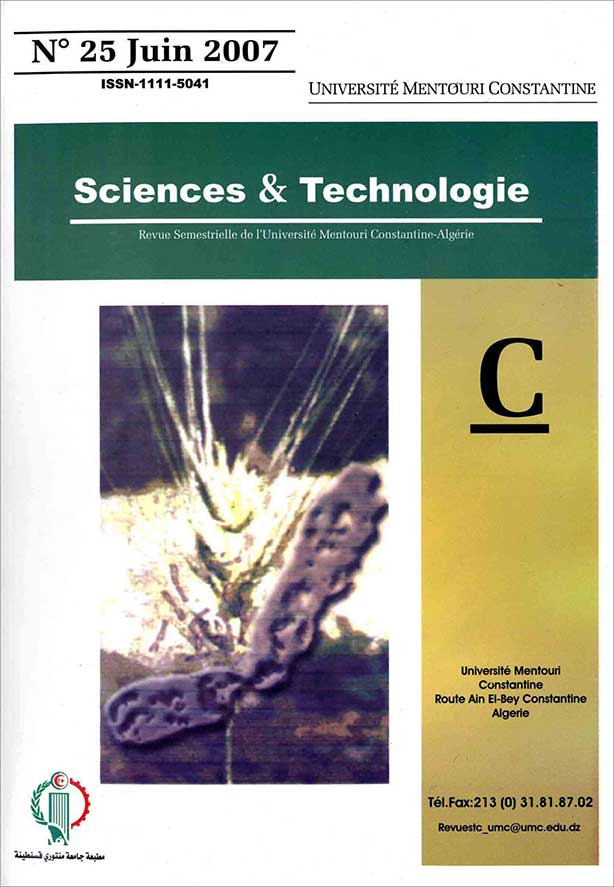EFFET DE L’ASSOCIATION DE BIFIDOBACTERIUM BIFIDUM AVEC Sreptococcus thermophilus SUR L’ACTIVITE ANTAGONISTE ENVERS Escherichia coli ENTEROPATHOGENE
Mots-clés :
Bifidobacterium, Streptococcus, Escherichia, fermentation, association,Résumé
The optimization of the acidifying power as well as the growth kinetics of Bifidobacterium bifidum, a strain of Streptococcus thermophilus has been associated with it in milk adapted for first age. The antagonistic effect in vitro appears after 4 hours of fermentation, in the presence of B.bifidum in a mixed culture with S. thermophilus. The inhibition percentage of Escherichia coli is 90 %. A decrease of E. coli number is observed after eight hours of fermentation in the presence B. bifidum alone. A great mortality of 50 % is noticed in the mice which have been given only E. coli
(set 1). The antagonistic effect in vivo during prophylactic treatment is significantly more important in the presence of two associated species (set 3) than in the case B. bifidum is given alone (set 2). In sets 4 and 5 (therapeutically treatment), a 89.5 % decrease in E. coli in faeces has been noticed during the 2nd day after a dose of fermented milk by B. bifidum in a mixed culture (set 5); but this effect is observed after the fifth when B. bifidum is given alone (set 4). The counts bacterial in the intestinal flora after the dissection of the mice show that B. bifidum and S. thermophilus are situated in the guts of the mice.
Références
- Akao T., Che Q.M., Kobashi K., Yang L., Hottari M.H. and Namba T., “Isolation of a human intestinal anaerobie Bifidobacterium sp strain SEN, capable of hydrolysing sennosides to sennidins”. Appl. Environ. Microbiol. 60, 3, (1994), pp. 1041 – 1043.
- Bertazzoni Minelli E., Benini A. and Vicentini L., “Intestinal microflora in premenstrual syndrome and effect of Lactobacillus acidophilus and Bifidobacterium bifidum administration”. Microecol. Ther. 25, (1995), pp. 223 – 230.
- Kheadr E., Bernoussi N., Lacroix C. and Fliss I., “Comparison of the sensivity of commercial strains and infant isolated of Bifidobacteria to antibiotics and bacteriocins”, Int. Dairy J., 14, (2004), pp. 1041-1053.
- Tamime A.Y., Marshall V.M.E. and Robinson R.K., “Microbiological and technological aspects of milk fermented by bifidobacteria”. J. Dairy Res. 62, (1995), pp. 151 – 187.
- Zourari A. et Desmazeaud M.J., “Caractérisation de bactéries lactiques thermophiles isolées des yaourts artisanaux grecs-II Souche de Lactobacillus delbrueckii subsp bulgaricus en culture mixte avec Streptococcus salivarius susp thermophilus”. Lait, 71, 4, (1992), pp. 463 – 482.
- Tanaka R. and Mutai M., “Improved medium for selective isolation and enumeration of Bifidobacterium”. Appl. Environ. Microbiol. 40, (1980), pp. 866 – 869.
- Anand S.K., Srinivasan R.A. and Rao L.K., “Antibacterial activity associated with Bifidobacterium bifidum” J. Cult. Dairy Prod. 19, (1985), pp. 6 – 8.
- Lee N.K. and Paik H.D., “Partial characterization of lacticin NK24, a newly identified bacteriocin of Lactococcus lactis NK24 isolated from Jeot-gal”, Food Microbiol., (2001), 18, 1, pp. 17-24.
- Van Der Wal F.J., Luirink J. and Oudega B., “Bacteriocin release proteins: mode of action, structure and biotechnological application”. FEM Microbiol. Rev., 17, (1995), pp. 381 – 399.
- Collado M.C., González R., Hernández M., Ferrús M.A. and Sanz Y., “Antimicrobial peptides are among the antagonistic metabolites produced by Bifidobacterium against Helicopter pylori”, Int. J. Antimicrob. Agents, (2005), pp. 385-391.
- Megrous J., Euloge P., Junelle A.M., Ballongue J. and Petidemange H., “Screeting of Bifidobacterium strain for bacteriocin production”. Biotechnol. Lett. 12, (1990), pp. 575 – 580.
- Duffy L.C., Zielezny M.A., Riepenhoff-Talty M., Dryja D., Griffiths E., Ruffin D., Barret H. and Ohra P.L., “Reduction of virus shedding by Bifidobacterium bifidum in experimentally induced MRV infection statistical application for ELISA”, Dig. Dis. Sci., 39, 11, (1994), pp. 2334-2340.
- Foster J.C., Glass M.D., Courtney P.D. and Ward L.A., “Effect of Lactobacillus and Bifidobacterium on Cryptosporidium parvum oocyst viability”, Food Microbiol,. (2003), pp. 351-357.
- Luquet F.M. et De Roissart H., “Les bactéries lactiques. Aspects fondamentaux et technologies”. Ed Lorica, Paris, 2, (1994), 614 p.
- Romond M.B., Haddou Z., Mielcareck C., and Romond C., “Bifidobacteria and human health: Regulatory effect of indigenous Bifidobacteria on Escherichia coli intestinal colonisation”. Anaerobe, 3, (1997), pp. 131 – 136.
- Raibaud P. et Ducluzeau R., “Etude de la colonisation bactérienne du tractus gastro-intestinal à l’aide de modèles expérimentaux”. Rev. Sci. Tech. Off. Int. Epiz. 8, 2, (1989), pp. 361 – 373.
- Berrada N., Lemeland J.F., Laroch G., Thouvinot P. and Piaia M., “Bifidobacterium from fermented milks: Survival during gastric transit”. J. Dairy Sci. 74, 2, (1991), pp. 409 – 413.
- Kaneko T., Mori H., Iwata M. and Meguro S., “Growth simulator for bifidobacteria produced by Propionibacterium freudenreichii and several intestinal bacteria”. J. Dairy Sci. 77, (1994), pp. 393 – 404.
- Dubey U.K. and Mistry V.V., “Growth Characteristics of Bifidobacteria in infant formulas”. J. Dairy Sci. 79, (1996), pp. 1146 – 1155.
- Leclerc D.A.A. et Mossel A., “Le tube digestif, l’eau et les aliments”. Ed. Doin, Paris, (1993), pp. 36 – 188.
- Kruse H.P, Kleessen B. and Blaut M., “Effects of inulin of faecal Bifidobacteria in human subjects”, British J. nutr., 82, (1999), pp. 375-382.
- Leahy S. C., Higgins D. G., Fitzgerald G. F. and. Van Sinderen D., “A Review Getting better with bifidobacteria”, J. Appl. Microbiol., 98, (2005), pp. 1303–1315..
- Marteau P.H., Pochard P.H., Bouhnik Y. and Rambaud J.C., “Fate and effects of some transiting microorganisms in the human gastrointestinal tract”. World Rev. Nutr. Diet. 74, (1993), pp. 1 – 21.
- Biavati B., Vescovo M., Torriani S. and Bottazzi V., “Bifidobacteria: history, ecology, physiology and applications”, Ann. of Microbiol., 50, (2000), pp. 117-131.
- Mitsuoka T., “Taxonomy and ecology of bifidobacteria“. Bifidobacteria Microflora., 3, 1, (1984),
pp. 11 – 28.
- Christopher M.D., Padmanabha Reddy V. and Venkateswarlu K., “Impact of feeding probiotic yoghurt containing Bifidobacterium bifidum DSM 20456 on growth performance in albino rats”, Tamilnadu J. Vet.Animal Sci., 2, 5, (2006), pp.154-157.
